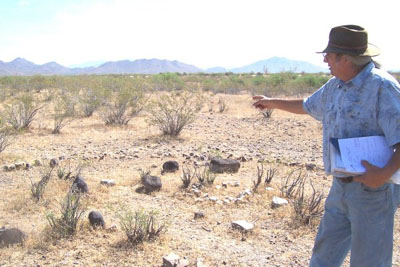Pete Norris is a man on a mission. His mission is to document and save ancient geoglyphs in the desert along Carefree Highway in Desert Hills AZ that are in
the path of future development. Geoglyphs are drawings made by ancient peoples on the ground, in this case using various size and types of rocks to form a pattern and tell a story.
Norris is an expert at crytanalysis, or the art of breaking codes. He believes that the geoglyphs he found in north Phoenix depict a known astronomical event some 4,000 years ago. The pattern and number of rocks clearly describe, to the trained eye, where the event happened and for how long. It tells of a meteor event, the number of meteor showers and the direction they crossed the ancient skies. The event is known to astronomers and has been recorded elsewhere in history on pottery and wall art and is documented to have occurred in 3,200B.C. “The sequences and the counts line up with this meteor event,” he said.
The only question is whether these geoglyphs are as ancient as the event itself or a retelling of the story by more recent inhabitants of the area. Other archaeologists claim it’s unlikely the formation is 4,000 years old. More likely it is consistent with other sites historically documented in the area about a 1,000 years ago. Norris admits it is unlikely
to be as ancient as when the event occurred.
“This is a known corridor for petroglyphs, art drawn on rock faces, by tribes about a
thousand years ago. They came through these mountain passes and left their art as
they passed through, Norris says. “This may have been a spiritual place where the
telling of ancient stories were handed down in the form of this geoglyph.”
When the land was recently sold it went through an archeological survey, the survey
team overlooked the site. Norris said he is shocked that it was missed. The area is slated for development with a road going right through the site. Norris has brought the site to the attention of the state and developers in hopes of preserving the site.
Still as a site 1,000 years old it is amazing it has survived relatively untouched for so
long, so near areas of development. Few people in urban areas get to experience
actual original geoglyphs. The rocks, mainly volcanic, with some quartz, are laid out in a pattern that Norris claims is a “Genesis II pictorial script,” a form of writing that predates even hieroglyphics. “The rocks have not been moved in recent times, except maybe one.” Norris maintains each stone’s placement, shape and size is significant.
Geoglyphs are drawings made on the ground historically created by either trenching the earth, revealing lighter colored earth below the surface, or by the placement of stones in specific patterns.
This geoglyph is small, only about 10 square yards. Perhaps the most famous geoglyphs in the southwest region are the Blythe Intaglios near the Colorado River best viewed from the air and are hundreds of yards long.
Watching the alignment of the sun each day over the course of a year, Norris has been able to verify the timeline depicted is consistent with other sites around the world. They all line up to these same dates which coincide with the start of this historic meteor event.
Norris says he is continuing to attempt to have the site dated and verified. His avocation lies in the interpretation of such sites, not the archaeology. “We really need to get some experts out here to see these geoglyphs before they are destroyed by construction.” Pete Norris can be contacted at 602-334-7209.


No comments:
Post a Comment